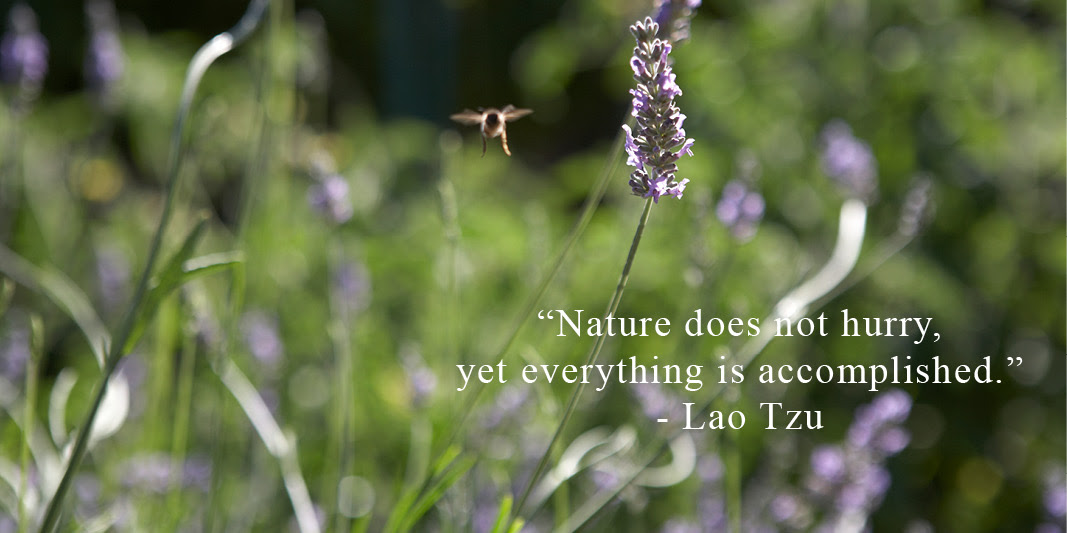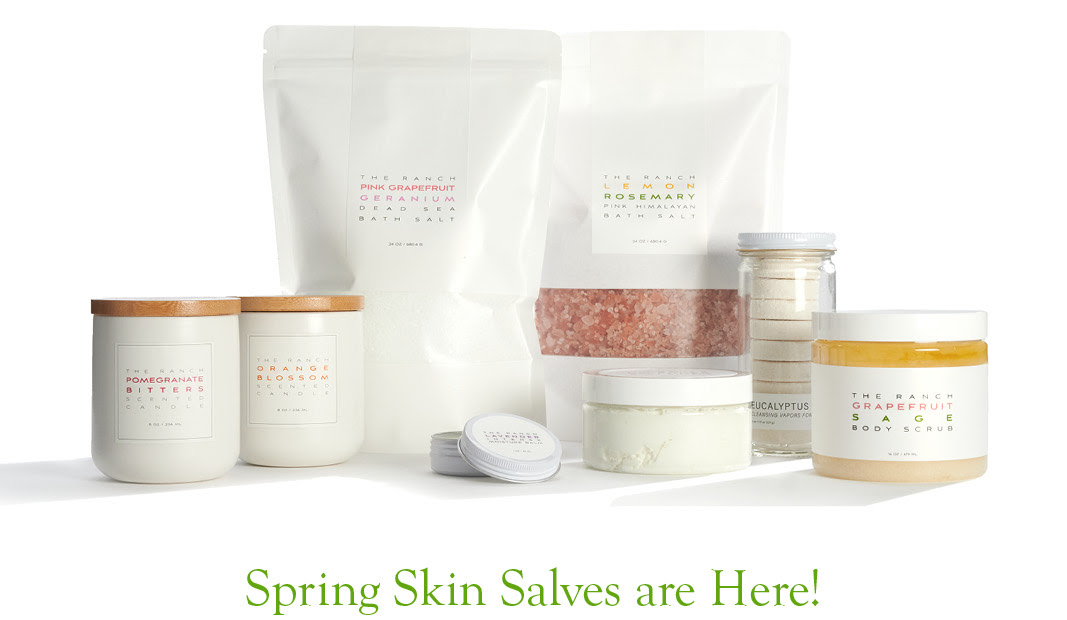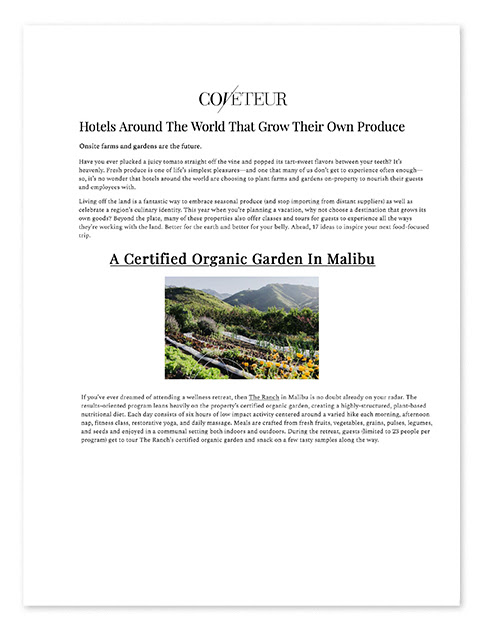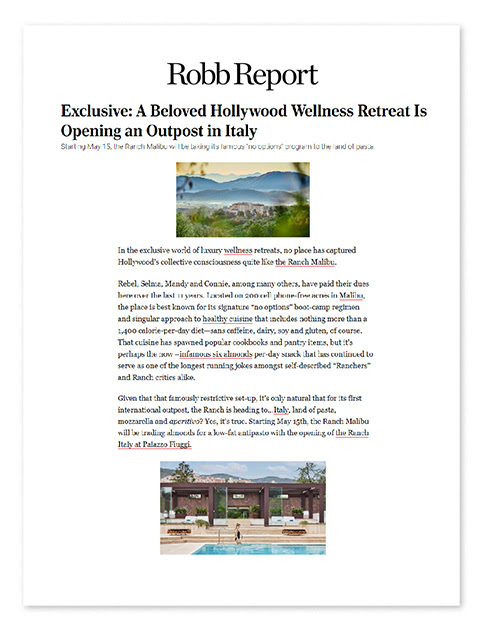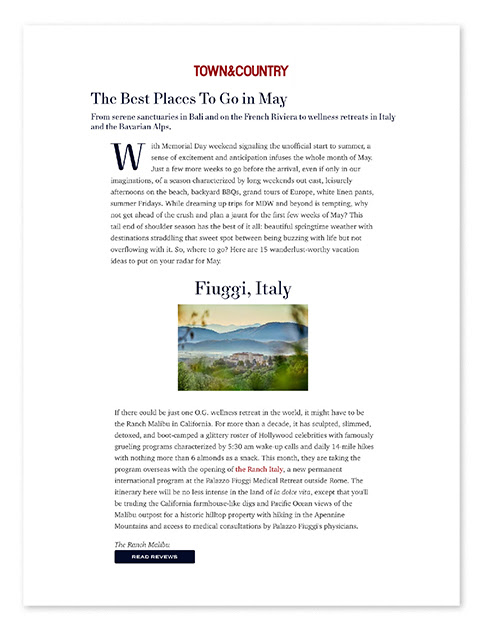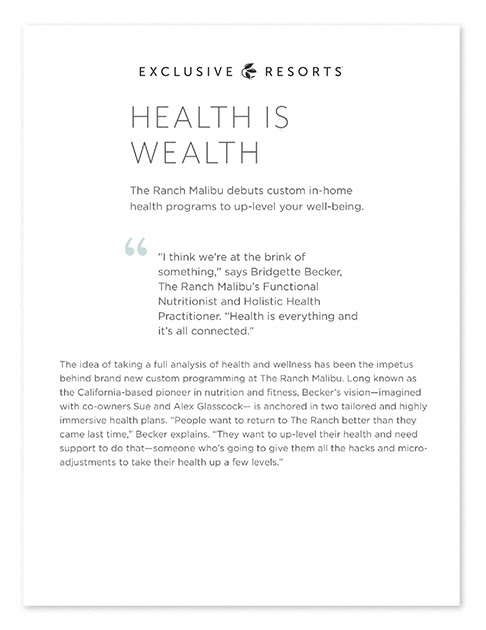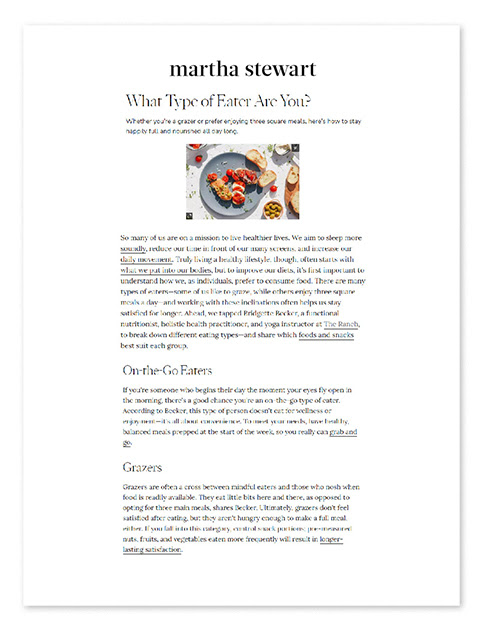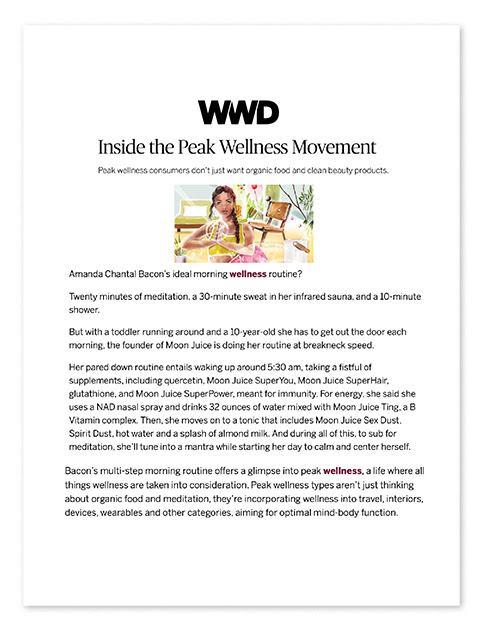A Note from Sue & Alex
Happy Earth Day Ranchers!
While there are so many lessons to be learned from nature, one of our favorites is the art of slowing down.
Technology has made us accessible 24/7 and many of us have lost the skill of relaxing and being engaged in life. Humans were not built to be constantly “on,” it raises our cortisol levels and negatively affects our adrenals. Our minds and bodies need time to“shut off” and relax. A few ways you can encourage this are by:
– Spending time in nature every day – nature has incredible abilities to heal and support the mind and body.
– Making movement a priority. Put your workouts in your calendar like you would an important meeting or appointment to help you stick to it!
– Practicing gratitude. It helps keep awareness in the present moment and trains the mind to seek the positive in life, rather than focusing on the negative. Each morning, write down 3 things you are grateful for as a way to honor this sentiment.
– Tune out the noise! Meditation, prayer, or just plain being aware of your breath for ten minutes a day can help alleviate the overstimulation, exhaustion and irritation so many of us feel from all the “noise”. If you need a little help with this, we have some breathing exercises below from Liv Oliveti, our Program Manager at The Ranch Italy.
However you decide to honor Earth Day, whether it’s by taking a cue from nature and slowing down, shopping for local and organic produce or volunteering to clean up a local park, beach or trail, we encourage you to make that a regular practice in your life.
In health,
~ Sue & Alex


Our new Italian immersion opens May 15th at Palazzo Fiuggi, an award-winning wellness medical spa – just 50 minutes from Rome! This 7-night 8-day (Sunday – Sunday) program is limited to 25 guests each week and pairs our signature program with the services and expertise of the medical team at Palazzo Fiuggi.
Our new at-home health programs are perfect pre-stay, post-stay or between visits and include 1:1 sessions with Functional Health Practitioner Bridgette Becker (who is profiled below), a personalized nutrition and lifestyle plan and the option of diagnostic testing.
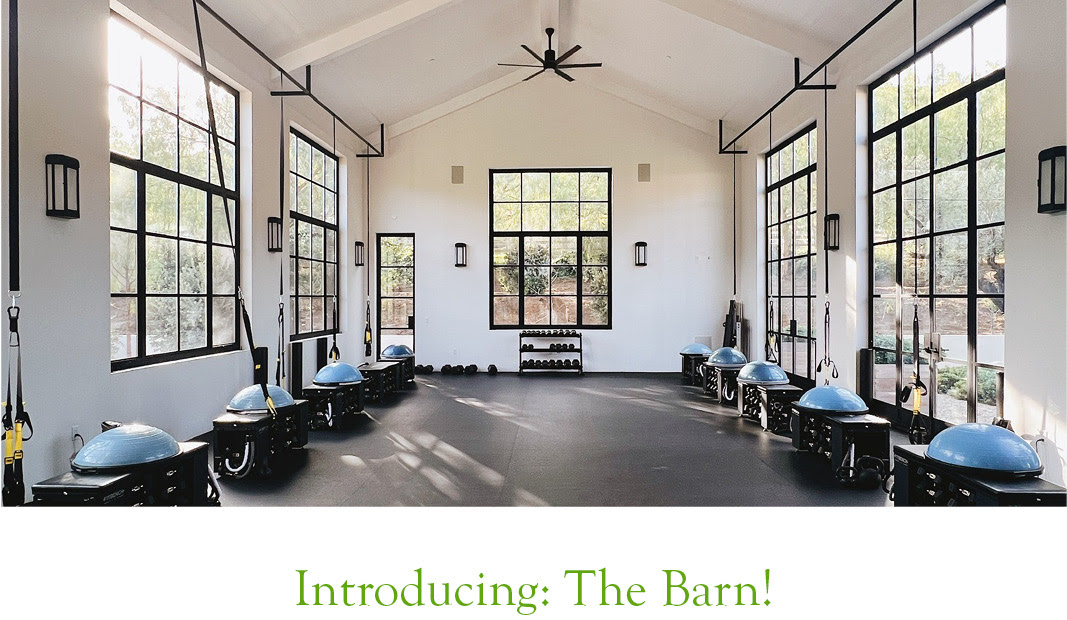
Malibu’s new 3,000 square foot fitness center is now the home for afternoon strength & yoga classes. Designed so that each guest has their own personal fitness area within the larger space, The Barn also features a 25-foot climbing wall, spin bikes, treadmills, weight training equipment and more!
Using ingredients straight from our garden, this new collection of bath & body products is safe for all skin types and features clean formulations designed to deliver results. From restorative and nourishing to exfoliating and invigorating, the line addresses a variety of concerns, healing parched skin and revitalizing the mind and body.


We are thrilled to welcome Functional Health Practitioner Bridgette Becker to our team! Bridgette joins us with 25+ years of experience, a wealth of knowledge and a devotion to supporting people on their path towards balanced and renewed health in mind, body and spirit.
Learn more about Bridgette and our new At-Home Functional Health Programs below.
– What are you grateful for?
My children, my family, nature, my health and every breath.
– What inspired you to become a functional health practitioner?
It was a combination of things. I was in many ways raised with this mindset. We grew most of our food. We had solar panels in the 80’s, and only went to the doctors if it was necessary despite both my grandfathers being physicians.
I also had a severe bone break when I was young that unfortunately took a bad turn. This experience prompted my desire to explore what other options are available for healing and recovery from injury or illness. I wanted to learn how to tap in to and support the body’s own capacity for healing, and to understand what gets in the way.
– What is the most rewarding part of your job?
When someone has a lightbulb moment about their health, and begins to feel empowered again to be in the driver’s seat to wellness.
– What is the difference between The Ranch Integrative Health Plan and The Ranch 360?
The Ranch 360 also offers more meal plans and all five labs – gastro-intestinal microbial assay, DUTCH complete hormone panel, heavy metal and mineral analysis, food sensitivity and blood panel. The Integrative Health Plan allows you to add on individual tests if desired.
![]()
– Who is The Ranch Integrative Health Plan best suited for?
This program is great for anyone and everyone – for those that just need a little support to people who are dealing with targeted therapeutic concerns.
– Who is The Ranch 360 best suited for?
The Ranch 360 is ideal for anyone who is ready to dive deep and commit to shifting their health in a profound way. Sometimes people are inspired to prioritize their health based on the circumstances around them, or because they themselves have grown weary of not feeling well.
This program will make a difference for anyone ready for change.

– Why is diagnostic testing an important part of these programs / who should consider adding one or all of them to their plan?
The diagnostic testing can make a profound difference in shifting health simply because of the information it provides. Most people are not routinely looking at gut function, heavy metal load or cortisol patterns on their annual testing, and all of these and more can burden the body, and impact function and performance. It allows any plan we create to be completely individualized and truly tailored to what will make the biggest difference.
– What type of results can one expect and how quickly will they start to see/feel them?
Results people may and often do experience include: increased energy, greater mental clarity, improved mood, weight loss, pain reduction, increased strength and endurance, less fatigue, less inflammation, bloating goes away, improved relationship with food.

– What do you think makes your approach so effective?
I have worked with and listened to my clients for decades. I understand the systems of the body as though they are personal friends, and how everything is connected. I also meet people where they are, and stay with them throughout their health journey.
I find working through the challenges is some of the most important work. Learning to really understand why we make the choices we make is a huge part of learning to make better ones.
– What are three simple changes that someone can do right now to improve their health?
1. Drink more water.
2. Eliminate processed foods, or anything with any type of chemicals.
3. Prioritize sleep, rest, breath-oriented movement and joy.
– While each person’s physiology is different, are there any universal foods that one should be getting more of in their diet? If so what are they and what are the benefits?
· Dark leafy greens – an incredible source of fiber, calcium and magnesium
· Seeds – they have fiber, protein and fat with a better beneficial fat ratio than nuts, are high in omega 3’s and are great sources of minerals.
· Sea vegetables (i.e. dulse, wakame, arame, hijiki, kombu, nori) – probably one of the highest mineral sources we can eat
· Berries – a great source of antioxidants

– Personal mantra or favorite quote?
Adopt the pace of nature, her secret is patience. – Emerson
– Last book you read?
The Heartbeat of Trees by Peter Wohlleben
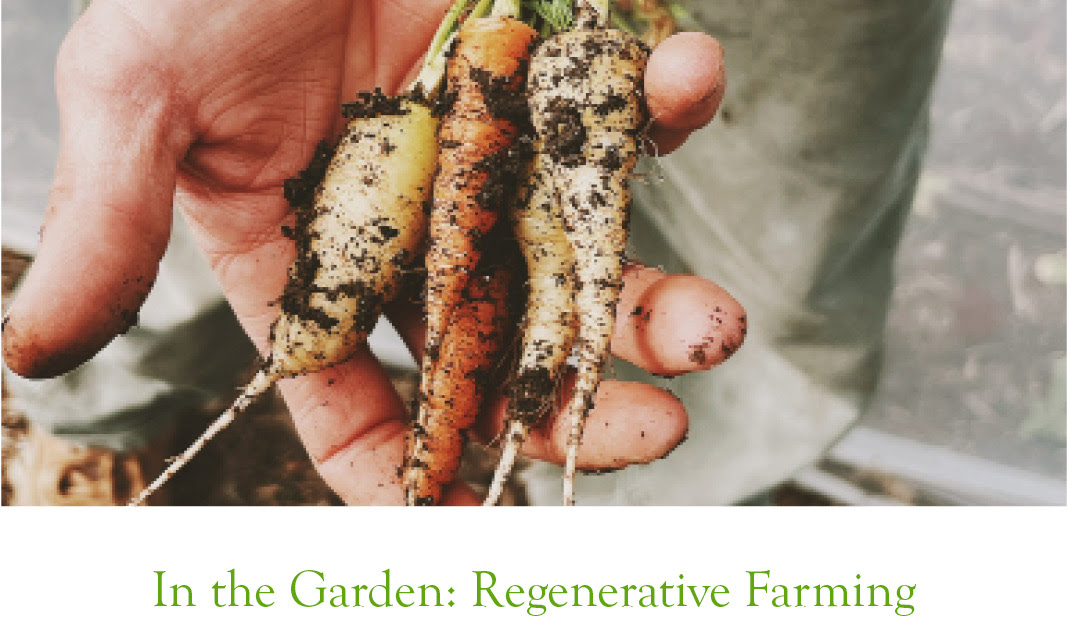
It’s all the buzz right now and for good reason. Regenerative farming improves soil health to not only improve the quality of the harvest but to benefit the surrounding ecosystem as well. It’s also the type of farming we practice at The Ranch!
Learn more about regenerative farming from our Farm Manager Jordan Wesley and how you can incorporate elements of this technique into your own garden.
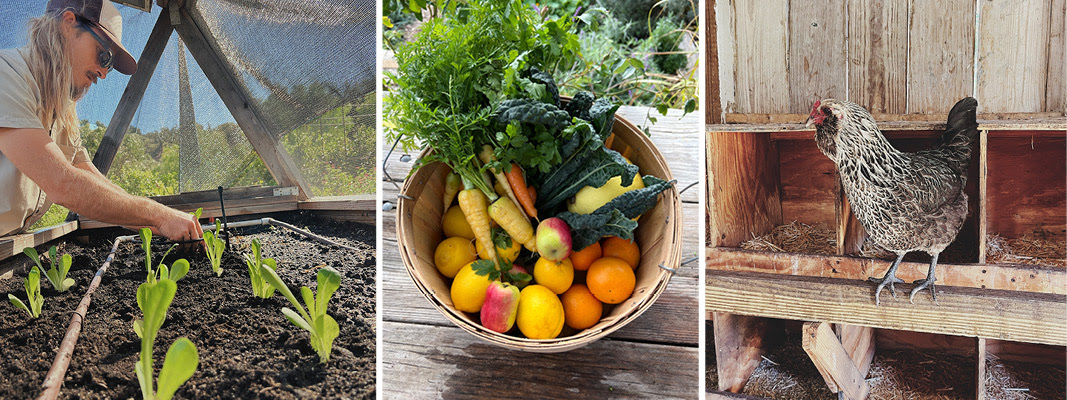
– What is regenerative farming?
Regenerative farming is the practice of cultivating an area of earth that results in greater fertility and biodiversity in that area and the surrounding ecosystem.
Regenerative farming remedies pollution and waste. It enhances the soil, air and water, and supports people, plants and animals with diverse edible landscapes.
– What are the key principles/practices of regenerative farming?
- Obtain a yield – produce something of value
- “Closed loops” – limit consumption and waste by using all parts of outsourced materials, and produce as many necessary materials as possible on-site. Examples include:
- Feeding kitchen scraps to chickens to limit feed and fertilizer costs
- Mulching the topsoil with shredded materials from the site
- Work with nature to cultivate with greater ease to the farmer and the natural environment. Examples include:
- Digging a pond where water naturally settles
- Growing edible native plants that already thrive in an area
- Capture rainwater, either with roofing gutters and tanks or strategic permaculture designs to retain more fresh water in your ecosystem.
- Build a community. We are all downstream from someone. Responsibly enhancing the landscape on our farm should create greater fertility and opportunity for our neighbors. For instance, try growing wildflowers around the perimeter of your farm to support wild birds and insects that will aid your neighbors’ farm.
- Responsible consumerism. It is ideal to produce your own livestock feed and plant fertilizers. However, it may be necessary to purchase products from outside sources. Choosing smaller local companies that also use responsible regenerative practices limits pollution and supports neighboring family businesses.
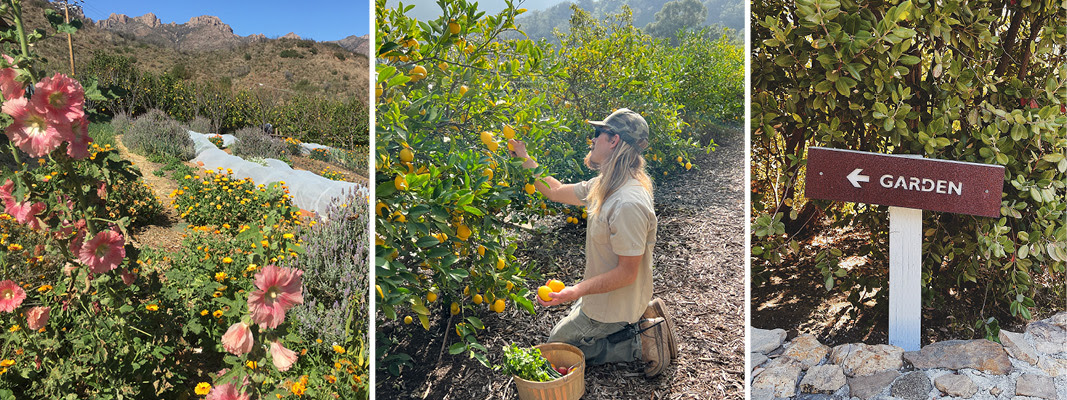
– What makes this type of farming so beneficial for the environment?
Regenerative farming is based on responsible observation of the natural systems. By supporting wild birds and beneficial insects while building a better water table underground, every species in the area will experience greater availability of food, water and shelter.
Regenerative farming limits the consumption of plastics, fossil fuels and other environmentally detrimental material waste. While conventional farming practices are eroding and destroying precious topsoil, regenerative farming builds topsoil and enhances the fertility of native soils.
– Why and in what ways do we practice regenerative farming at The Ranch?
- Growing cover crops to feed organic material to the soil
- Companion planting. We strategically grow multiple crops in the same space at the same time that will feed and support each other. This results in multiple harvests with less demand for nutrients or pesticides. (Ex. corn, beans and squash)
- Planting wildflowers and filling birdbaths to support birds and bees who in turn pollinate fruit/vegetable flowers and eat bad bugs
- Producing our own fertilizer from the chicken coop and worm bins
- Limiting feed purchases by giving kitchen scraps to the chickens
- Limiting nutrient purchases by producing compost on-site
- Saving the seeds from our vegetables and flowers to limit the cost of purchasing seeds
- Building a pond to capture rainwater
- Purchasing organic materials from responsible companies in our area
– Are there benefits to eating food farmed through regenerative practices that make it more ideal than other types of farming techniques?
One of the greatest benefits of eating food grown through regenerative practices is the higher nutritional value and better taste. Regenerative cultivation results in produce with a higher Brix content since it is not fertilized by synthetic chemicals in poor soil.
Another benefit of eating food from a regenerative farm is the reduced carbon footprint. Less packaging, less fossil fuel and less plastic is involved – all of which are major pollutants from conventional farming.
– What can one do to incorporate the principles of regenerative farming into their own garden?
- Compost all kitchen scraps and yard waste. Don’t give away your organic material!
- Start a composting worm bin to produce your own worm castings from kitchen scraps
- Plant wildflowers and save seeds
- Collect rainwater from your roof gutters to irrigate your garden
- Consume responsibly by buying organic from local family businesses
- Mulch all of your cultivated spaces and bare soil to reduce evaporation, runoff, erosion and build organic material into the soil
- Cultivate varieties that grow easily in your area
- Practice crop rotations, including cover crops
- Place fresh water in bird and bee baths outside
- Share your experiences with other gardeners so we can all be successful producers
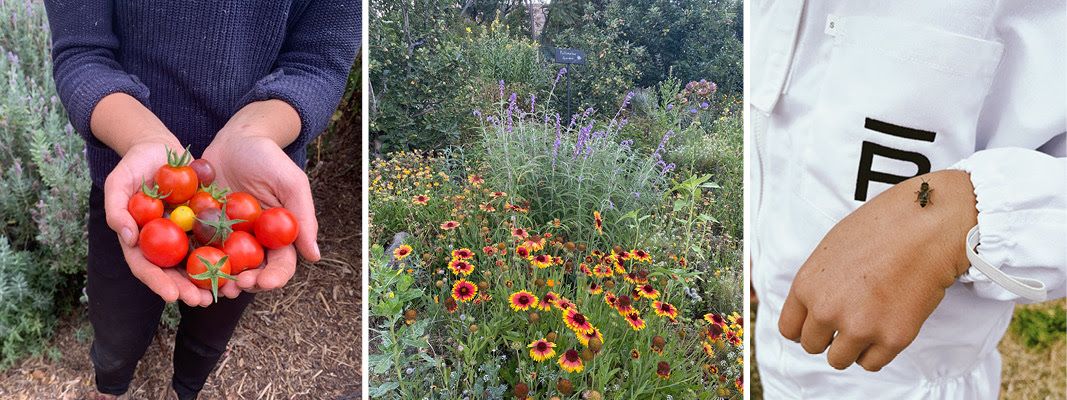
– Are there any plants that find this type of farming particularly beneficial?
Almost all plants benefit from regenerative farming practices. We are all pioneers in our growing spaces, especially with climate change. Ask other farmers in your area about their experiences and successes.
Finding the ideal planting date, companion plants and fertilizer needs of a plant in your garden comes with careful observation and practice over multiple seasons. For a simple home garden, corn, beans and squash is a great companionship to start with, as are tomatoes and basil.
-Anything more to add?
Large-scale conventional farms are destroying topsoils around the world while making a mess of pollutants. Grow your own food whenever possible and support small, local family farms as often as you can- the planet with thank you!
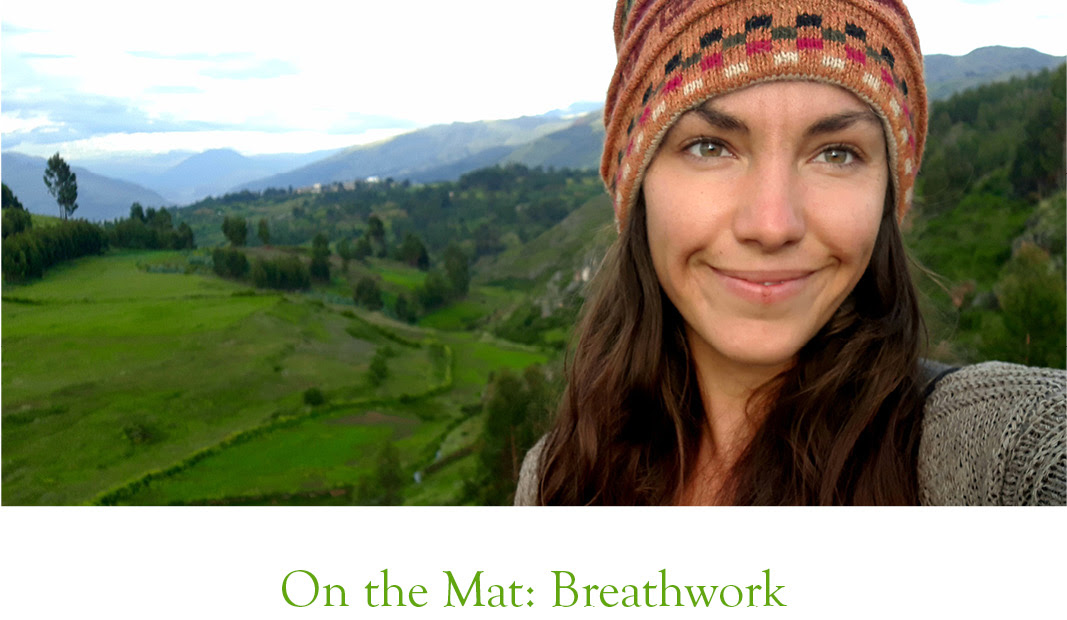
Breathing is the most vital process in our bodies, and yet many of us breathe poorly and incorrectly. Rhythmic, deep and slow breathing calms and soothes a busy mind and can even increase our lung capacity. Learning to focus and control your breath is a skill you can literally do and use any time or place to regulate an over-stimulated body or mind.
To help you hone the power of your breath, we’ve tapped The Ranch Italy Program Manager and lifelong yogi Liv Oliveti to share a beginner’s guide to breathwork to use whenever and wherever you need it – including the hiking trails!
Ancient yogis were keen observers of nature and the human body and devised numerous breathing exercises to reestablish equilibrium in the body and mind. In today’s day and age, where we lead stressful lives and often have irregularities in our lifestyles, we can still gain many benefits from these practices called Pranayama.
Without basic breath awareness, no breathwork can be done, so these elementary techniques should help to get you started. Do these practices with your eyes closed and in the following order if possible, as one leads very naturally to the next.
While there isn’t a suggested time allotment for each, focusing on something such as breathing can be difficult with our “monkey” brains hopping around from one thought to another. Take the time to unwind and concentrate in order to reap the full benefits of these techniques.
And remember, something is better than nothing! If you can only do a few of these exercises, you can still experience the benefits of focused breathwork.

BASIC SPONTANEOUS BREATH AWARENESS
Become aware of the two phases of every breath, the inhale and the exhale. This can be done in numerous ways and positions and at any time during the day. Whenever possible, try to choose a quiet, clean and calm setting to practice in.
Position your hands on your abdomen or chest and concentrate on the movement of the body under the hands.
Then, count your breaths – inhale, exhale one, inhale, exhale two, etc.
Observe how at every inhale the abdomen and chest rise and expand and at every exhale they fall and release.
LENGTHENING THE TWO PHASES OF THE BREATH
Work up to the point of having the inhale and the exhale last the same amount of time.
Start with a low number, for example: inhale to a count of 3, exhale to a count of 3.
Gently challenge yourself by experimenting with increasing the time of each inhale and exhale.
Stop when you are out of breath.
YOGIC BREATHING
This third step should be done seated and in a comfortable position. If you have back problems, you may sit up against a wall for support.
After you’ve focused on your spontaneous breath for a few minutes, try following the flow of every inhale into your body.
Think of the breath rising from the depths of your pelvis as it expands the abdomen, filling all the way up through the chest, expanding the chest until at the end of the inhale you may feel expansion under the clavicle as well.
Then, follow every exhale as it travels vertically from the top of the chest, all the way back through the torso and downwards into the depths of the pelvis, relaxing and releasing.
Keep observing every inhale and every exhale in this way.
UJJAYI PRANAYAMA, THE PSYCHIC BREATH
This type of breath is particularly helpful in soothing the nervous system and relieving insomnia.
After you’ve done yogic breathing so that your breath has become calm and rhythmic, bring your attention to the throat.
Contract the throat gently so that a sound is produced like the breathing of someone who is asleep. Think of it as an audible hissing sound at the back of your throat. Focus on this sound. It should be delicate and not very loud.
Repeat for a few cycles.
BHRAMARI PRANAYAMA, THE HUMMING BEE BREATH
This practice should be done in a comfortable seated position and is known to relieve anger, anxiety and insomnia while lowering the blood pressure.
Relax the muscles around the mouth. The teeth should be slightly separated and your jaw should be relaxed.
Bring your awareness to the nose. Follow the inhale as it goes up through the nostrils and down again with every exhale.
After you’ve done this for a few cycles, plug the ears with your index fingers.
Breathe in through your nose and while exhaling slowly, make a deep steady hum that sounds like a honeybee. The humming sound should last for the entire exhale and should be smooth, constant and soft.
At the end of the exhale, take a deep inhale and repeat. Do this for several more rounds.

HOW TO USE YOUR BREATH ON TRAIL OR DURING PHYSICAL EXERTION
We’ve all been there, winded and exhausted during a strenuous hike or challenging workout. Even though you are in constant movement and cannot do as complex of breathwork as you can while seated or motionless, there are still simple techniques to enhance the breath and help keep the body energized and oxygenated for optimal physical performance.
Option 1
Notice how your breath changes in relation to what you are doing.
Train yourself to breathe through the nose, instead of the mouth. It’s not as easy as it sounds. To begin with, start by inhaling through the nose and exhaling through the mouth and vice versa.
After training in his fashion for a little bit, you can slowly experiment with inhaling and exhaling exclusively through the nose for short periods of time, which can then be lengthened with time.
Option 2
Breathe with the abdomen when feeling out of breath or under stress. This uses the entire lungs, so it improves oxygenation and gas exchange through your body and muscles.
In order to do this, even while hiking, try to place your hand over your belly button and breathe.
Focus on the feeling of your belly pushing against your hand during the inhale, and releasing the pressure with the next exhale.
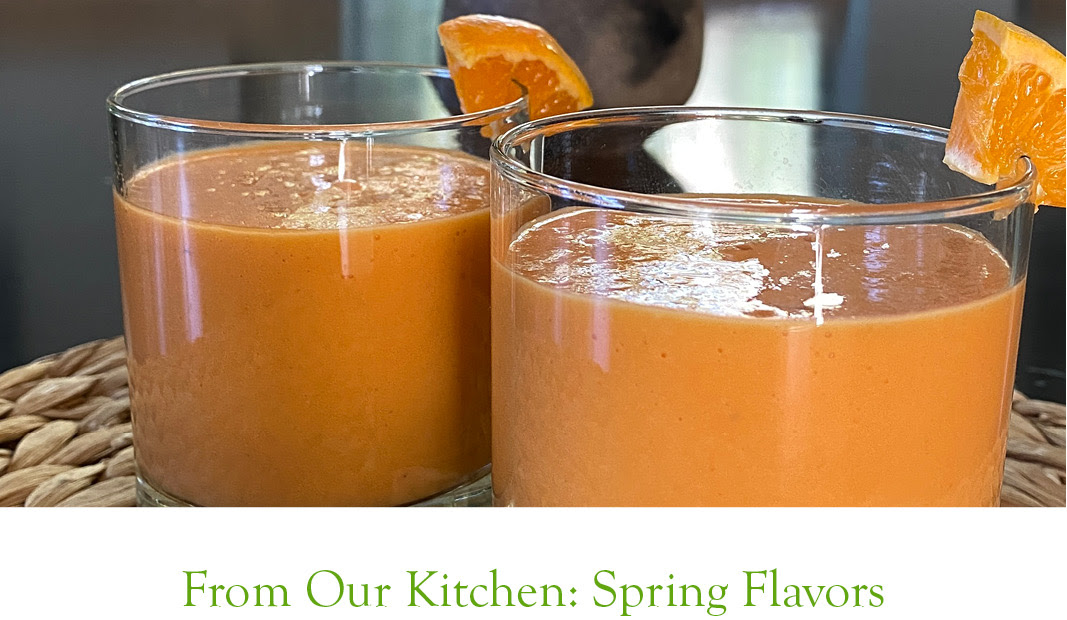
The colors and flavors of the season are on full display in our garden, leaving Chef Meredith and her culinary team filled with inspiration as they create dishes incorporating these ingredients in a variety of ways. Expect to see these recipes on the menu in both Malibu and Italy in the coming weeks!
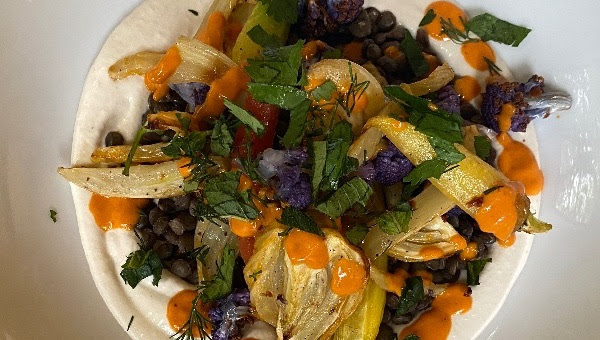
Roasted Carrots & Fennel with Harissa Dressing, Black Lentils and Cashew Yogurt
Serves 4
Ingredients:
1 pound baby heirloom carrots, trimmed, scrubbed and sliced in half lengthwise (or in quarters if they are large)
1 pound fennel, about 2 medium bulbs, washed and sliced lengthwise into thin sections
1 medium red onion, peeled and sliced into eighths
1 Tbsp avocado oil
1 Tbsp harissa paste
Salt & pepper
1 cup cashew yogurt (recipe follows or your preferred store-bought brand)
zest of 1 lemon
1 cup black beluga or French green lentils
a handful of mint, dill, cilantro or basil leaves, roughly chopped
For the Harissa Dressing
¼ cup olive oil
1-2 tsp. harissa paste, to your spice level
2 Tbsp. freshly squeezed lemon juice
½ Tbsp. maple syrup
pinch of salt, to taste
For the Cashew Yogurt
(if making your own, this will need to be done at least 6 hours ahead of time)
2 cups raw cashews
1 1/2 cups water
2 probiotic capsules
Directions:
Preheat oven to 400°F.
Place the carrots on a baking sheet and rub with 1/2 Tbsp each of avocado oil and harissa paste. Sprinkle with salt and pepper.
Place the fennel and red onion on a separate baking sheet and rub with the other half of the oil and paste.
Place the veggies in the oven and roast for 25-35 minutes, until they are tender and charred around the edges. The fennel and onions may take longer than the carrots, so remove the carrots first if necessary.
While the vegetables are roasting, cook the lentils and make the dressing. Start by washing the lentils well and then draining them. Rinse until the water runs clear.
Place them in a medium saucepan and cover them with plenty of water. Bring to a boil, then reduce to a simmer and cook covered for about 15 minutes. Add about a half teaspoon of salt, stir and continue to simmer covered, until the lentils are tender, about 5 more minutes. Drain and rinse.
Combine the lemon zest and yogurt.
To assemble, divide the yogurt and lentils among four plates. Pile the vegetables on top, sprinkle with herbs, and drizzle the dressing over it.
To Make the Dressing:
While the lentils are cooking, whisk the dressing ingredients together. Start with a teaspoon of harissa paste and add more to suit your taste.
To Make the Cashew Yogurt:
Place the cashews in the blender, along with the water and blend on high until completely smooth and creamy.
Transfer the mixture to a plastic or glass bowl and sprinkle the contents of the probiotic capsules over the surface. Gently stir with a rubber spatula (not a metal utensil to avoid any reaction).
Cover the bowl with cheesecloth or a thin tea towel and secure it with a rubber band. Place it in a warm spot on the counter and let stand for at least 6 hours or overnight – the longer it sits, the tangier it will get. The finished yogurt will keep in an airtight container in the refrigerator for up to a week.
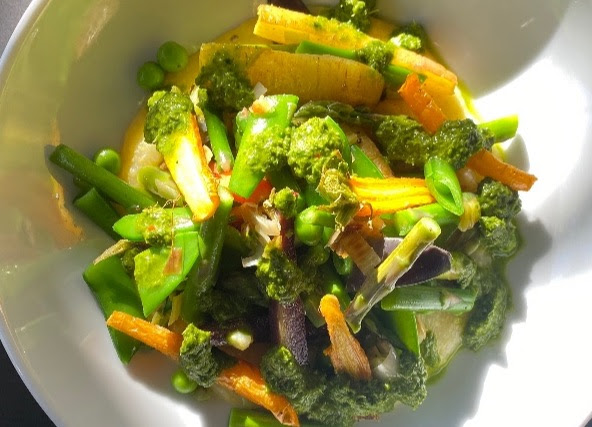
Spring Vegetables with Polenta
Serves 4
Ingredients:
For the Polenta
1 cup organic cornmeal polenta
1/4-1/2 cup almond milk
1-2 Tbsp nutritional yeast
Salt & pepper to taste
For the Vegetables
1 Tbsp oil
1 cup cremini mushrooms, quartered
1 leek, cleaned and chopped
1 cup asparagus, ends removed and cut into 1-2 inch pieces
1 cup sugar snap peas, halved if large
1/2 cup frozen peas
Salt & pepper to taste
For the Gremolata
1 bunch flat-leaf parsley, roughly chopped
2 garlic cloves, minced
Zest of 1 lemon
Juice of half a lemon
1/4 cup olive oil
Salt & pepper to taste
To Make the Polenta:
Add 3 cups of water to a medium pot, adding 1 tsp salt as it comes to a boil.
With the water at a simmer, slowly pour in the polenta, whisking all the while. Cook on low heat for 20 minutes, whisking occasionally. Add in 1/4-1/2 cup more water, if needed.
Add in the almond milk and nutritional yeast. Stir to combine and season to taste.
To Make the Vegetables:
As the polenta is cooking, in a large pan, heat the oil over medium heat.
Add the mushrooms and sauté for 4-5 minutes. Add in the leek, asparagus and snap peas. Cook for another 5-8 minutes, until the asparagus and snap peas are bright green. Season with salt and pepper.
Add in the peas at the end of cooking, just to warm through.
To Make the Gremolata:
In a food processor, add the parsley, garlic and lemon zest and pulse until chopped. Add the lemon juice, oil and salt and pepper and blend again until combined and slightly chunky. Season to taste.
Serve the polenta with vegetables on top and drizzle with gremolata sauce.

Carrot Mango Smoothie
Serves 2
Ingredients:
Juice of 1 orange
1 medium carrot, washed
1 cup frozen mango or pineapple
1/2 banana
1/2 cup water or almond milk
Directions:
In the blender, puree ingredients until smooth and creamy.


Airhead: The Imperfect Art of Making News
By Emily Maitlis
Deep Work
By Cal Newport
Imagine It!
By Laurie David & Heather Reisman
Extra Time: 10 Lessons for an Aging World
By Camilla Cavendish
How Emotions are Made
By Lisa Feldman Barrett
The Mind-Body Stress Reset
By Rebekkah LaDyne
The Power of Less
By Leo Babauta
Wise Trees
By Diane Cook & Len Jenshel


